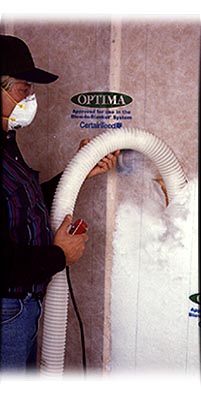Blown-in insulation
Blown-In Insulation
insulUSA uses two different types of blown-in insulation: fiberglass and cellulose. The fiberglass based blown-in insulation is made from molten glass that is spun into fibers. Most manufacturers use 20%–30% recycled glass content.
Cellulose blown-in insulation is composed of up to 85% recycled newsprint. The remaining content is most commonly a mixture of ammonium sulfate and borate that functions as a fire retardant. These chemicals also deter insects, rodents, and mold.
How Is Blown-In Insulation Applied?
Blown-in insulation must be applied using an insulation blowing machine and is designed for both open-blow applications (such as attic spaces) and closed-cavity applications (such as walls or vaulted ceilings). Blown-in insulation creates a tight fit in each stud cavity and seals around all outlets, pipes, wires, etc. The tight seal created makes blown-in insulation a great sound barrier as well as insulator. Our installers are trained to eliminate settling by creating the perfect combination between the netting and the amount of compression in each cavity.
Types of Blown-In Insulation
There are three variations to the blown-in fiberglass and cellulose options above. They are fiberglass Blown-In-Blanket (BIB), Dry Pack Cellulose and Spray Applied Cellulose. The first two are similar in that the wall/ceiling is covered with a 'netting' that serves to tightly contain the material in each cavity and eliminate settling. Spray Applied Cellulose is different because the cellulose is mixed with a latex adhesive, misted with water to activate the glue, and blown into wall cavities.
Why Blown-In Insulation?
Blown-in insulation is very popular in open wall spaces and will dramatically reduce your heating and cooling costs. Not only will it reduce your monthly utility bills but you can take advantage of the rebates and tax credits from the utility companies and the federal government. Learn more about available energy efficiency rebates and tax credits.

